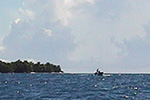Colombian president, Juan Manuel Santos, announced over the weekend that there will be no oil exploration in the award-winning Seaflower Biosphere Reserve and Marine Protected Area (MPA). Spreading over 65,000 square kilometers (6,500,000 hectares), Seaflower MPA is home to over a hundred coral species, over 400 fish, some 150 birds, four marine turtles species, and the magnificent mollusk, the queen conch (Strombus gigas).
“We have been studying the issue with the Minister of Environment and will not allow signing of exploration,” President Santos said while visiting the island of San Andres.
The Seaflower MPA was awarded top honors for innovative conservation at the Convention on Biological Diversity (CBD) in Nagoya, Japan last year. Coralina, the Colombian government agency that established the reserve with local community involvement, beat out over 1,000 other entires to take home the prize.
The reserve allows sustainable fishing and harvesting by locals, as well as programs to create additional livelihoods without negatively impacting the ecological integrity of the region.
Many locals were fiercely opposed to oil exploration in the region. June Marie Mow, Executive Director of the local organization Providence Foundation, told mongabay.com that if the Colombian government went ahead with oil exploration it would be ‘environmental and social aggression’.
The Seaflower MPA lies within the Colombian Caribbean department of the Archipelago of San Andres, Old Providence and Santa Catalina. The islands are home to around 80,000 people including the ethnic and cultural minority: the Raizal people.
Related articles
‘Environmental and social aggression’: oil exploration threatens award-winning marine protected area

(12/01/2010) The Seaflower Marine Protected Area (MPA), which recently won top honors at the Convention on Biological Diversity (CBD) in Japan, is now under threat by planned oil exploration in the region, according to the Providence Foundation which is devoted to protecting the area. Proposed blocs for exploration by the Colombian government lie in the North Cays adjacent to the park, and perhaps even inside MPA boundaries. Spreading over 65,000 square kilometers (6.5 million hectares), Seaflower MPA lies within the Colombian Caribbean department known as the Archipelago of San Andres, Old Providence and Santa Catalina. This richly diverse Archipelago is home to a known 57 coral species, over 400 fish, and some 150 birds, as well as the ethnic and cultural minority: the Raizal people. The prospect of massive infrastructure or, even worse, oil spills in the area could devastate the park and locals’ livelihoods.
Colombian marine reserve receives top honors at global biodiversity meeting
(10/20/2010) Coralina, a Colombian government agency that established the Seaflower Marine Protected Area (MPA) with local community involvement, is being heralded today by the Convention on Biological Diversity (CBD) in Nagoya, Japan. Proving that conservation and sustainable economic opportunities can go hand-in-hand, Coralina was instrumental in creating a marine park that protects nearly 200 endangered species while providing sustainable jobs for local people in the Western Caribbean Colombian department of Archipelago of San Andrés, Old Providence and Santa Catalina. Coralina was one of over 1,000 agencies and organizations that are apart of the Countdown 2010 program, which highlights effective action to save species at the CBD.